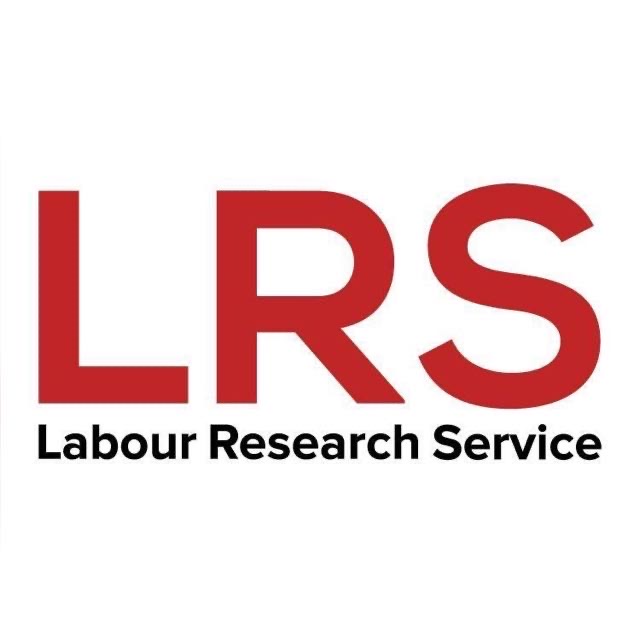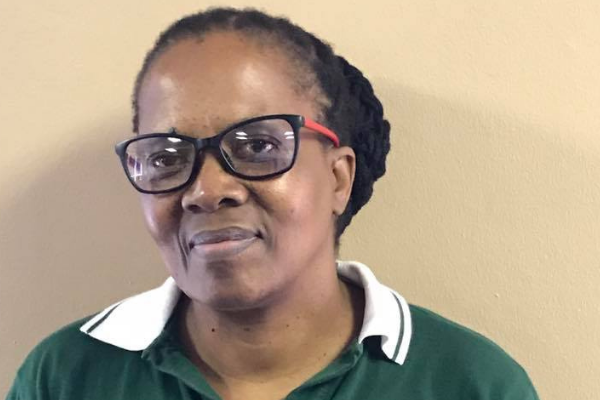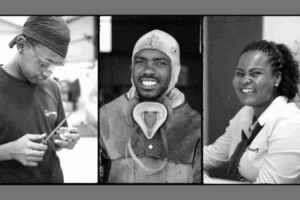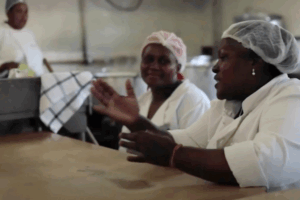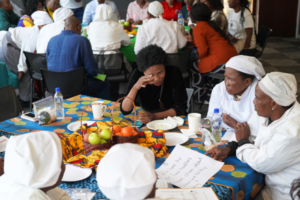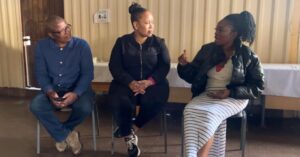The majority of the nurses in South Africa are women and many of them are members of the Health & Other Services Personnel Trade Union of South Africa, (HOSPERSA). Together with HOSPERSA and Gender at Work, the LRS piloted a multi-year collective impact project for reducing gender-based violence at Meadowlands Clinic in Gauteng. The project helped to improve conditions for workers at the clinic, as well as the frosty relationship between the clinic and the local community members. Amid the novel coronavirus, Baby Moipone Ntoula, HOSPERSA shop steward and Nurse Clinician at Meadowlands Clinic, speaks about the conditions at work and decisions faced daily by the nurses dealing with healthcare challenges posed by the pandemic.
What has been your experience since South Africa began to confront the covid-19 pandemic?
President Cyril Ramaphosa announced the lockdown in March 2020. As essential workers, we’d continue to work as normal. The District Manager convened an urgent meeting with shop stewards to tell us about the operational guidelines for covid-19, such as changes to the workplace environment and how to adapt to the changes. We shared the information with the workers. As a HOSPERSA shop steward representing workers at Meadowlands Clinic, the first thing I thought about was the transportation situation of colleagues. I wasn’t confident that management would provide the platform to discuss key concerns for workers, for example, adequate protective equipment (PPE) and safety. I took the initiative to seek advice from the union, and our general secretary communicated our concerns to the Department of Health. However, the department didn’t respond directly to the union. In April 2020 we found out from the sub-district transport department that transport has been made available, yet it wasn’t announced.
How did the clinic change in the light of the covid-19 pandemic?
The set up has changed as per the new directives. Most patients except the urgent cases must queue outside for mandatory screening by the two or three staff members stationed at the gate for screening purposes. One individual is screened at a time and ten people are ushered while maintaining social distancing. It can be challenging to maintain social distancing. Some patients don’t understand and others don’t want to, but we are trying to adhere.
Four containers have been set in the clinic compound to act as chest clinic, HIV, TB, and COVID-19 testing sites. Patients who’ve been screened are directed to a different department. For directions, the clinic has been marked blue and red or orange. Blue zone is for normal alert, red or orange zone is for danger. Chronic patients, mother and child and psych patients have their designated waiting areas for not more than twenty patients at a time to maintain social distancing measure.
Would you tell us more about the screening process?
The following questions are asked: Have you recently been coughing? Have you been coughing for more than two weeks? Do you have a sore throat? Do you have a recent loss of taste and smell? The temperature of every person is checked. Patients who answered yes to one of the questions or have high temperature are known as a patient under investigation. They are sent to the chest clinic.
The chest clinic is like a normal exanimation room. It has medicines and emergency equipment such as oxygen cylinders, masks, pulseoximeter and BP machines. The clinicians dress in plastic apron disposable caps, gloves, masks and boots when examining the patients and taking proper history. HIV testing is mandatory, but patients are not obligated. If a patient tests positive they get treatment immediately. The patient moves to TB testing and lastly to the covid-19 testing.
The clinicians who test for covid-19 are in full protective equipment; cap, face shield, disposal gown, and gloves and boots. Not every patient who goes to the chest clinic ends up being tested for covid-19.
Patients don’t touch their files during this whole process. Also, each patient uses the same chair throughout the whole process and leaves it at the clinic gate on their way out. The chairs are sanitised by a cleaner who doubles up as a runner, handling the files between the clinicians and staff doing the HIV testing. The staff assigned to work in the sites at the compound can’t enter inside the clinic expect to use ablution facility or to get their food.
It is amazing to hear Meadowlands Clinic is well prepared to respond to the pandemic. How did it happen?
We weren’t organised at the beginning. The covid-19 is new and we didn’t know what to expect. Workers were confused about many things, for example, if it was sensible to wear masks only considering how the virus spread. All workers wanted to dress like they were going to the moon – with the full bodysuit. But we made peace with the situation and protected ourselves as per the issued guidelines.
PPE is a thorny issue. In March we only had enough handwashing soap and not enough toilet paper and hand towels. The few sanitisers got finished fast due to covid-19 and it was difficult to replenish. Luckily I got sanitisers from FEDUSA and shared with the workers. Those who would afford it bought their own, but it was a struggle. Orders for cleaning materials were placed but the deliveries took long. I worked closely with the institutional manager and added the weight of organised labour in the effort to push for quick deliveries. We’d get the stock eventually but it wasn’t enough. Fortunately, we now have enough stock.
Healthcare workers are having to deal with many unexpected issues. Labour found an ally in the health department manager who was present during the covid-19 response meeting. This manager has a reputation for getting the work done and providing what is needed to sustain the work. For example, within a day this official organised a new geyser to replace the malfunctioned one that we first reported in October 2019.
What items are considered as PPE?
Some examples of personal protective equipment are disposal caps, boots, surgical masks, N95 masks, plastic apron, visors/face shields, gowns and goggles. The Department of Health has guidelines on the use of PPEs. The screening staff wear masks only, practise social distancing, use hand sanitiser before and after handling patients’ appointment cards. Triaging staff have masks and plastic aprons, and gloves when they need to touch patients, while the staff in consultation rooms have masks and plastic aprons, and gloves to use when touching patients. At the covid-19 testing site, the staff have masks, disposal gown, caps, boots, gloves, goggles, face shields/visors and plastic aprons.
How do you think the community view the pandemic?
In Meadowlands, life appears to be normal. Everybody was in the street conducting their business. The long queue at Pick n Pay Centre may be the different thing because the security was controlling the queue. Most of the people are poor and imposing a total lockdown and telling them to stay indoors when many live in confined spaces without any form of entrainment, becomes a huge struggle. From what I can see, patients at the clinic seem not to be afraid of covid-19 as some feel they are still going to die of the cold and other diseases.
What challenges have you encountered personally?
Covid-19 has affected everybody. We are working in areas which are not our speciality. We were afraid that some of the gains we had made through the gender-based violence pilot project with Labour Research Service would scatter. The long queues and waiting time that the patients are subjected to made them start complaining that we are evil again. The infrastructure outside the clinic gate where a queue is currently formed worsens with the rains. On the day it rained we found it difficult to work outside and to maintain social distancing in the clinic’s small shelter. The patients said we didn’t care and swore at us.
How did you handle the situation?
We told the patients that the pandemic is beyond our control and we can only do our best. We made them aware we aren’t to blame for the new changes issued by the Department of Health. Some of the patients called the covid-19 number and the complaints toll-free number to report ‘bad behaviour’, only to learn the new approaches are the norm for now. This calmed the situation somehow. As for the staff, we weren’t comfortable with the situation. Workers weren’t happy regarding the guidelines about PPE. We had a lot of questions thrown at shop stewards and we didn’t have answers. We didn’t always know what to ask in management meetings as the pandemic is new.
Has the department increased education about the covid-19 and the measures for tackling it?
We get guidelines and protocols but they change frequently. On any given day, we receive different information but I don’t always have the time to read the guidelines because I also work as a clinician. The planned training on guidelines didn’t happen so we are learning as we go along. One such meeting involving the institutional manager and labour didn’t go well. We didn’t get to the guidelines, which was the reason for the meeting. Instead, facilitators were bombarded with the concerns in workplaces. Workers used the platform to talk about the issues that are affecting them.
How did the pandemic affect you personally?
I didn’t want to go to work. I would have palpitations in the mornings after getting ready to go to work. The slight tremor in my right hand worsened and made it difficult to hold a pen sometimes. I would phone my manager to say I wouldn’t make it to work, and not because I was sick. I simply couldn’t muster the strength. Unfortunately, I seem to be the only one at work who is outspoken about the anxiety, which sometimes causes tense moments among ourselves. Clinic staff don’t understand that health facilities can’t be shut down if a colleague has tested positive for covid-19.

